The NVIDIA GeForce GTX 1080 Preview: A Look at What's to Come
by Ryan Smith on May 17, 2016 9:00 AM ESTGaming Performance, Power, Temperature, & Noise
So with the basics of the architecture and core configuration behind us, let’s dive into some numbers.
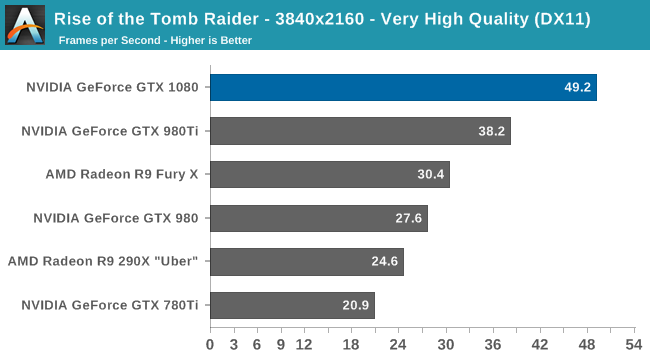

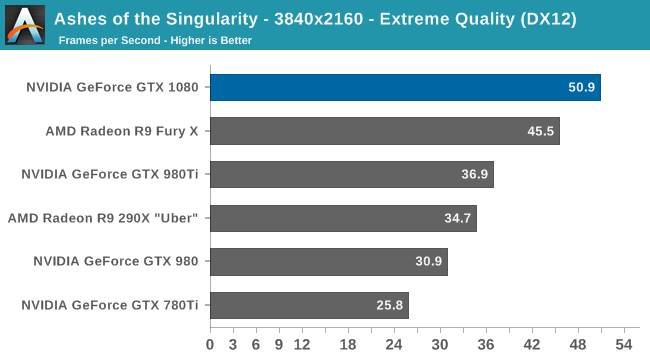

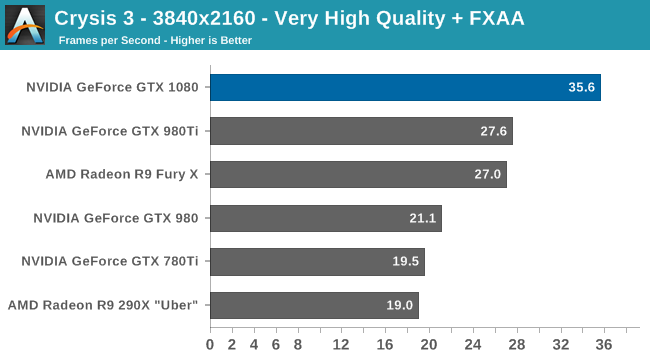
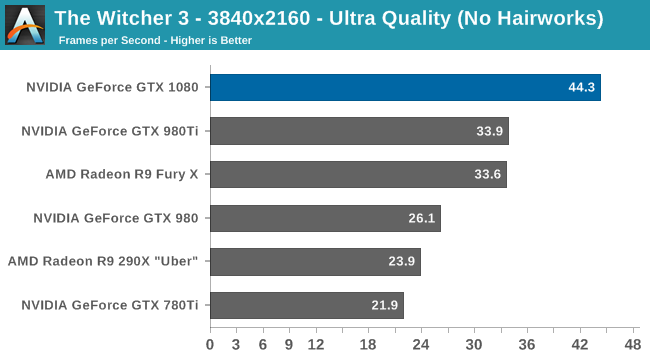
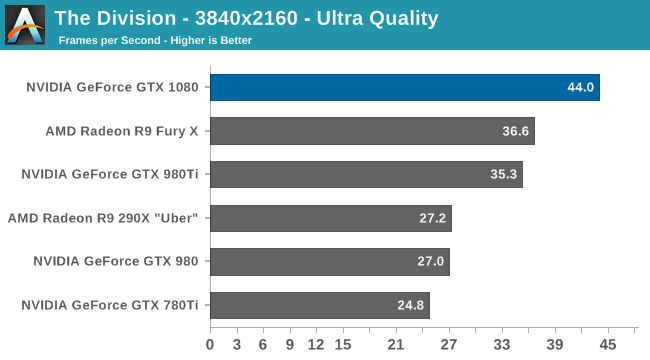
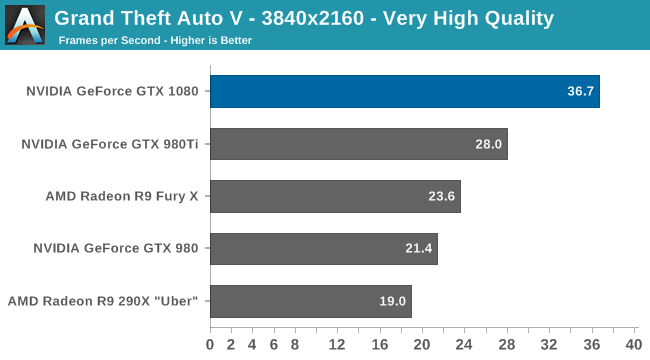
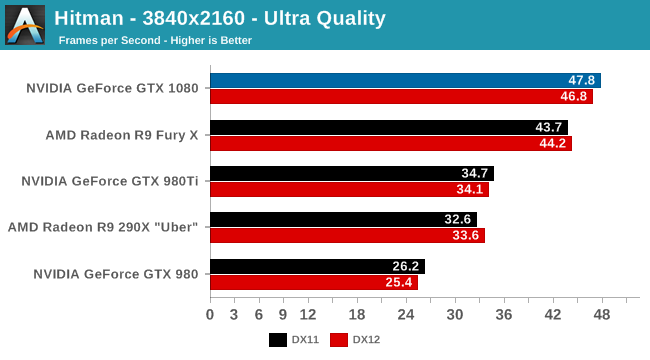
As the first high-end card of this generation to launch, NVIDIA gets to set the pace for the market. At the risk of being redundant the GTX 1080 is now the fastest single-GPU card on the market, and even at 4K it wins at every single gaming benchmark, typically by a good margin. In practice we’re looking at a 31% performance lead over GTX 980 Ti – the card the GTX 1080 essentially replaces – with a similar 32% lead over AMD’s Radeon R9 Fury X. Meanwhile against the slightly older GTX 980, that gap is 70%.
On a generational basis this ends up being very close to the 74% jump in 4K performance going from the GTX 680 to GTX 980. And although the pricing comparison is not especially flattering for NVIDIA here, it should be evident that NVIDIA isn’t just looking to sell GTX 1080 as an upgrade for high-end Kepler cards, but as an upgrade for GTX 980 as well, just 20 months after it launched.
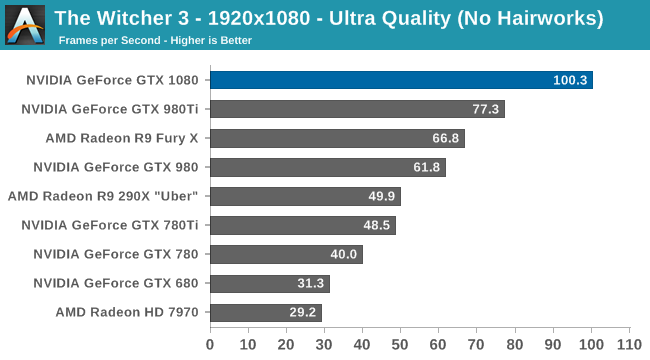
I also wanted to quickly throw in a 1080p chart, both for the interest of comparing the GTX 1080 to the first-generation 28nm cards, and for gamers who are playing on high refresh rate 1080p monitors. Though this will of course vary from game to game, roughly speaking the GTX 1080 should be 3x faster than the GTX 680 or Radeon HD 7970. This is a good reminder of how architectural efficiency has played a greater role in past years, as this is a much larger gain than we saw jumping from 55nm to 40nm or 40nm to 28nm, both of which were much closer to the historical norm of 2x.

Meanwhile when it comes to power, temperature, and noise, NVIDIA continues to execute very well here. Power consumption under Crysis 3 is some 20W higher than GTX 980 or 52W lower than GTX 980 Ti, generally in line with NVIDIA’s own TDP ratings after accounting for the slightly higher CPU power consumption incurred by the card’s higher performance. The end result is that GTX 1080 is a bit more power hungry than GTX 980, but still in the sweet spot NVIDIA has carved out in the gaming market. Broadly speaking, this amounts to a 54% increase in energy efficiency in the case of Crysis 3.
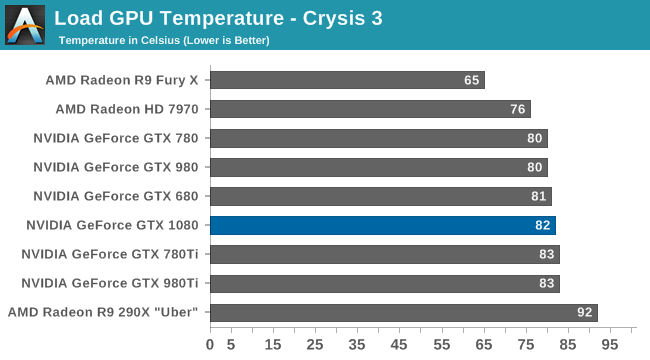
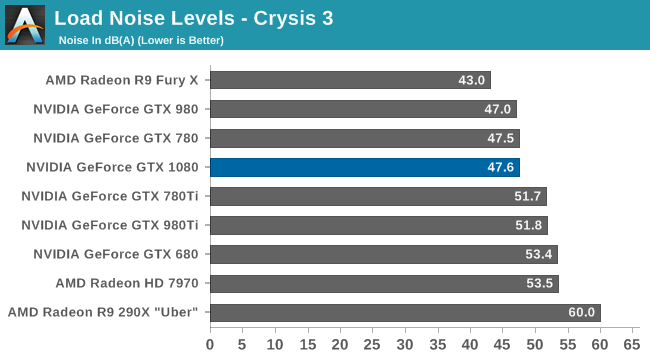
Otherwise from a design perspective the GTX 1080 Founders Edition carries on from NVIDIA’s high-end GTX 700/900 reference design, allowing NVIDIA to once again offer a superior blower-based solution. NVIDIA’s temperature management technology has not changed relative to Maxwell, so like their other cards, the GTX 1080 tops out in the low 80s for load temperature. More significantly, at 47.5 db(A) load noise, the card is on par with the GTX 780 and half a dB off of the GTX 980.
Ultimately NVIDIA has designed the GTX 1080 to be a drop-in replacement for the GTX 980, and this data confirms just that, indicating that GTX 1080’s much higher performance comes with only a slight increase in power consumption and no meaningful change in temperatures or acoustics.


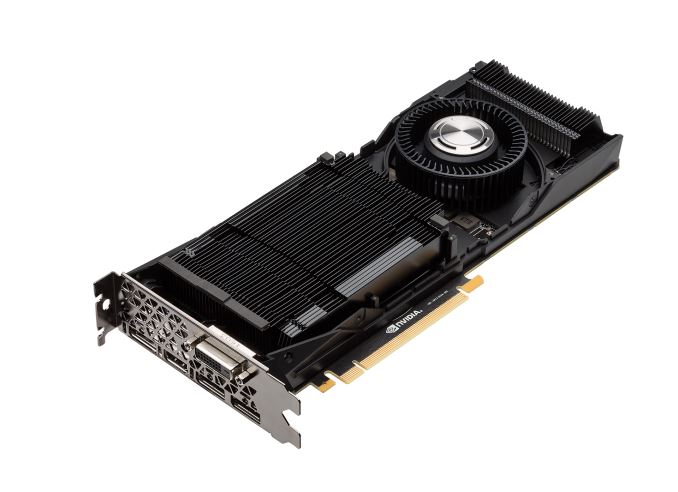








262 Comments
View All Comments
Yojimbo - Tuesday, May 17, 2016 - link
From the rumors, I doubt the P10 is going to touch 1070 performancedragonsqrrl - Wednesday, May 18, 2016 - link
The 4000 series didn't start at the middle. The 4870 was the high-end card in the stack.The highest-end Polaris 10 based card is rumored to perform similarly to the 390X. So quite a bit below early estimates for the 1070.
Lolimaster - Tuesday, May 17, 2016 - link
AMD and Nvidia knew that HBM2 will not be ready for mass production until Q4 2016 early 2017.Yojimbo - Tuesday, May 17, 2016 - link
Isn't it over 4 times faster than a 670? If the 670 still works for you will something being 10 times faster make a difference? Are you looking to jump up from 1080P with low qualities settings to 4K with high quality settings?bananaforscale - Wednesday, May 18, 2016 - link
Funny, I'm thinking of replacing my 770, but with a 1070, because lower TDP, faster memory and more of it and more eye candy. Granted, I may find I need to upgrade the CPU too but that's life, and it's approaching five years old anyway...rtho782 - Tuesday, May 17, 2016 - link
I wish there were 1440p benchmarks, with the advent of monitors like the RoG Swift this is the most common "step up" from 1080p these days.Eden-K121D - Tuesday, May 17, 2016 - link
They did well considering how nvidia positioned it as a single card solution for 4k.ZeDestructor - Tuesday, May 17, 2016 - link
You may find bench to be of relevance to you then: http://www.anandtech.com/bench/product/1714?vs=171...Eden-K121D - Tuesday, May 17, 2016 - link
I have a question are second hand 350-400$ 980Ti cards a good buyRussianSensation - Tuesday, May 17, 2016 - link
Wait for GTX1070 review to decide. I would estimate that if you have the patience to wait for after-market $380-400 GTX1070 cards, there will be a better buy than a used 980Ti.